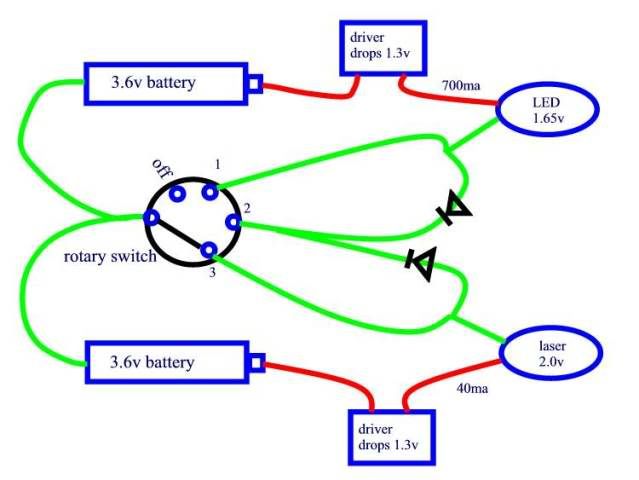Hi, I have some basic questions about a circuit I want to try:

IR led and laser, 14500 batteries, drivers are the same as the DDL but use LM1086 for lower dropout.
It's a ground interrupt via rotary switch. 4 modes: led, led & laser, laser, off.
1 - is it "kosher" to use the batteries as independent power supplies but with a shared ground? From an engineering standpoint, is there a reason to not do this?
2 - the 1N4001 diodes are to prevent either load from finding a ground when they should be off. Ex: the picture shows the circuit in Laser-Only mode, and the LED remains off because the diode in the LED bus blocks the "alternate ground pathway". ...I think. Will a diode provide that function on the "back side" of a circuit?
3 - the diodes have a .7v dropout. Theoretically, there's only a 0.3v potential remaining "after" the laser. Does this mean that the diode will rob 0.4v from the laser, or will the laser still have it's full 2.0v?
Sorry if my questions are "basic", but I'm not an ee, just a hack.
Thanks!

IR led and laser, 14500 batteries, drivers are the same as the DDL but use LM1086 for lower dropout.
It's a ground interrupt via rotary switch. 4 modes: led, led & laser, laser, off.
1 - is it "kosher" to use the batteries as independent power supplies but with a shared ground? From an engineering standpoint, is there a reason to not do this?
2 - the 1N4001 diodes are to prevent either load from finding a ground when they should be off. Ex: the picture shows the circuit in Laser-Only mode, and the LED remains off because the diode in the LED bus blocks the "alternate ground pathway". ...I think. Will a diode provide that function on the "back side" of a circuit?
3 - the diodes have a .7v dropout. Theoretically, there's only a 0.3v potential remaining "after" the laser. Does this mean that the diode will rob 0.4v from the laser, or will the laser still have it's full 2.0v?
Sorry if my questions are "basic", but I'm not an ee, just a hack.
Thanks!



